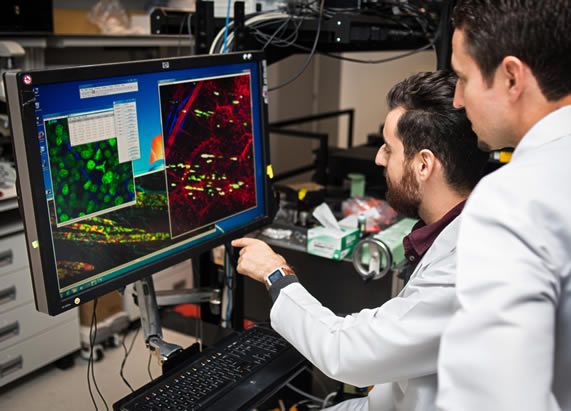PhD Public Seminar: BARBARA NASSIF RAUSSEO
When & Where
July 16
3:00 PM - 4:00 PM
UTHealth Houston, MD Anderson Cancer Center, ACB1.2345 and via Zoom (View in Google Map)
Contact
- Joy A. Lademora
- 7135009872
- [email protected]
Event Description
Studies of the Mechanisms of Reverse Signaling by CD40L
Barbara Mercedes Nassif Rausseo, BS (Advisors: Alexandre Reuben, PhD and Gregory Lizee, PhD)
CD40 ligand (CD40L) is a transmembrane protein expressed on activated CD4 T cells, traditionally known for its role in forward signaling by engaging CD40 on antigen- presenting cells to promote immune activation. While this pathway is well characterized, there is evidence that CD40L also mediates reverse signaling, acting as a signaling receptor on T cells which enhances T cell function. However, the extent, consequences, and mechanism of CD40L-mediated reverse signaling in CD4 T cells remain poorly defined. This dissertation investigates the mechanisms and effects of CD40L reverse signaling on T cell function using both primary human T cells and the Jurkat T lymphoblastoid cell line. Crosslinking CD40L with monoclonal antibody 5c8 induced upregulation of activation markers CD69 and CD25, ERK1/2 phosphorylation, and secretion of key cytokines including IFN-γ, IL-2, and TNF-α in primary CD4 T cells. In contrast, reverse signaling in Jurkat cells elicited phosphorylation of pERK1/2 but little to no cytokine production, limiting their usefulness as a model for studying downstream consequences of reverse signaling. A synthetic SH2-domain binding array identified Abl1/2, CRK, and CRKL as candidates that interact with the highly conserved phosphorylated tyrosine residue at position 5 (Y5) in the CD40L cytoplasmic domain. To assess structural requirements, CD40L constructs with either a cytoplasmic domain deletion or a Y5F point mutation were evaluated. Surprisingly, neither mutation impaired ERK1/2 phosphorylation, suggesting that this domain might not be essential for initiating some intracellular signaling events. Moreover, neither mutation affected the ability of costimulation to mobilize intracellular CD40L to the cell surface. However, the deletion of the cytoplasmic domain reduced overall protein expression, indicating a potential role for the cytoplasmic domain in CD40L stability or translation efficiency. Together, these findings contribute to the growing body of knowledge that CD40L can function as a signaling receptor in CD4 T cells, triggering intracellular pathways that influence activation and cytokine production. These studies also suggest that the cytoplasmic domain is dispensable both for mobilization of CD40L to the cell surface, and for induced phosphorylation of ERK1/2.
Advisory Committee:
- Alexandre Reuben, PhD, Chair
- Gregory Lizee, PhD, Co-Chair
-
- Michael Davies, MD, PhD
- William Plunkett, PhD
- Katy Rezvani, MD, PhD
Join via Zoom (Please contact Ms. Barbara Nassif Rausseo for her Zoom meeting information.)
Studies of the Mechanisms of Reverse Signaling by CD40L
Barbara Mercedes Nassif Rausseo, BS (Advisors: Alexandre Reuben, PhD and Gregory Lizee, PhD)
CD40 ligand (CD40L) is a transmembrane protein expressed on activated CD4 T cells, traditionally known for its role in forward signaling by engaging CD40 on antigen- presenting cells to promote immune activation. While this pathway is well characterized, there is evidence that CD40L also mediates reverse signaling, acting as a signaling receptor on T cells which enhances T cell function. However, the extent, consequences, and mechanism of CD40L-mediated reverse signaling in CD4 T cells remain poorly defined. This dissertation investigates the mechanisms and effects of CD40L reverse signaling on T cell function using both primary human T cells and the Jurkat T lymphoblastoid cell line. Crosslinking CD40L with monoclonal antibody 5c8 induced upregulation of activation markers CD69 and CD25, ERK1/2 phosphorylation, and secretion of key cytokines including IFN-γ, IL-2, and TNF-α in primary CD4 T cells. In contrast, reverse signaling in Jurkat cells elicited phosphorylation of pERK1/2 but little to no cytokine production, limiting their usefulness as a model for studying downstream consequences of reverse signaling. A synthetic SH2-domain binding array identified Abl1/2, CRK, and CRKL as candidates that interact with the highly conserved phosphorylated tyrosine residue at position 5 (Y5) in the CD40L cytoplasmic domain. To assess structural requirements, CD40L constructs with either a cytoplasmic domain deletion or a Y5F point mutation were evaluated. Surprisingly, neither mutation impaired ERK1/2 phosphorylation, suggesting that this domain might not be essential for initiating some intracellular signaling events. Moreover, neither mutation affected the ability of costimulation to mobilize intracellular CD40L to the cell surface. However, the deletion of the cytoplasmic domain reduced overall protein expression, indicating a potential role for the cytoplasmic domain in CD40L stability or translation efficiency. Together, these findings contribute to the growing body of knowledge that CD40L can function as a signaling receptor in CD4 T cells, triggering intracellular pathways that influence activation and cytokine production. These studies also suggest that the cytoplasmic domain is dispensable both for mobilization of CD40L to the cell surface, and for induced phosphorylation of ERK1/2.
Advisory Committee:
- Alexandre Reuben, PhD, Chair
- Gregory Lizee, PhD, Co-Chair
-
- Michael Davies, MD, PhD
- William Plunkett, PhD
- Katy Rezvani, MD, PhD
Join via Zoom (Please contact Ms. Barbara Nassif Rausseo for her Zoom meeting information.)
", "startDate":"2025-7-16", "endDate":"2025-7-16", "startTime":"15:00", "endTime":"16:00", "location":"UTHealth Houston, MD Anderson Cancer Center, ACB1.2345 and via Zoom", "label":"Add to Calendar", "options":[ "Apple", "Google", "iCal", "Microsoft365", "MicrosoftTeams", "Yahoo" ], "timeZone":"America/Chicago", "trigger":"click", "inline":true, "listStyle":"modal", "iCalFileName":"Reminder-Event" }






